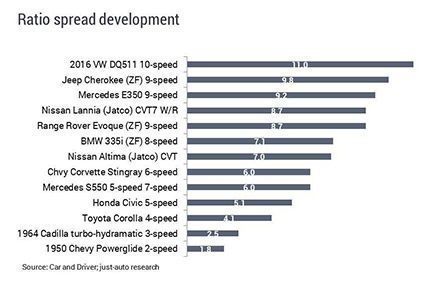
Earlier this week the announcement by JATCO of a new transmission, the innocuously named CVT7 W/R, passed by with relatively little fanfare save for its reporting on the pages of just-auto.
However, what it did mark was the increasing importance of transmission ratio spreads in OEMs’ and suppliers’ efforts to reduce CO2 emissions and the fact that the CVT can now compete on a relatively level playing field, in efficiency terms, with step-automatics and DCTs, and perhaps become part of the solution set for OEMs headquartered outside of Japan once again.
First to ratio spreads and what they are. Simply they are the ratio of a transmission's lowest gear divided by the ratio of its highest. They are garnering more attention as reducing losses derived from the engine, thus reducing CO2 output, is becoming more expensive due to the more straightforward steps such as downsizing, downspeeding and stop-start having already been taken. Transmission development sometime provides a more cost-effective alternative, although increasingly a “systems engineering” approach is required so that transmission and engine development is complementary. Increased ratio spreads in transmissions broaden the range in which an engine can operate optimally. Also, wider ratio spreads are an enabler for downsized and downspeeded engines – with their typically narrower operating sweetspots – to both launch effectively with lower ratio 1st and 2nd gears and cruise economically with taller top gears.
Whereas past 4-speed automatics might have had a spread of 3.5-4.0, the latest automatics such as ZF's 9-speed in the Range Rover Evoque can boast of a ratio spread of 8.7. As illustrated by the ZF 9-speed the best way to achieve a wider ratio spread is to increase the number of ratios. The increase in forward gear number is not just limited to automatic transmissions. Indeed, VW's forthcoming DQ511 10-speed DCT has a ratio spread of 11, becoming a new benchmark for the industry when it enters the market in 2016.
Up until very recently, CVTs were not capable of getting close to the ratio spreads of step-ATs and DCTs and traditionally had a ratio spread of around 6.0. However, JATCO has directed resources to overcome the ratio spread limitations of traditional CVTs. This initially resulted in the launch of the Jatco CVT7 (or APO) in 2009 and CVT8 (or ARO) in 2012, which circumvented steel belt limitations of the time with the addition of a small auxiliary planetary gear giving a ratio spread of just over 7.0.
This week’s launch of the latest and greatest JATCO CVT – the CVT7 W/R – also uses an auxiliary planetary gearbox but also sees the adoption of new steel belt technology and improvements to the pulley. The result is a ratio spread of 8.7, the exact same as ZF’s lauded 9-speed as used by the likes of Acura, Jeep and Land Rover. Furthermore, the fuel efficiency benefit is stated as 3%.
How well do you really know your competitors?
Access the most comprehensive Company Profiles on the market, powered by GlobalData. Save hours of research. Gain competitive edge.

Thank you!
Your download email will arrive shortly
Not ready to buy yet? Download a free sample
We are confident about the unique quality of our Company Profiles. However, we want you to make the most beneficial decision for your business, so we offer a free sample that you can download by submitting the below form
By GlobalDataThe CVT market is growing globally in any case – a long-term CAGR of 2.2% is forecast by just-auto’s QUBE service – but continued development of the technology, could see it start to increase in popularity among OEMs outside of Japan after many previous false dawns.




